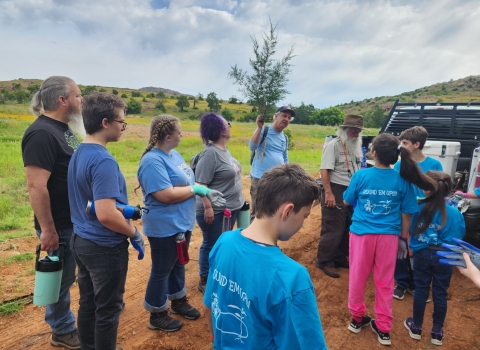Wichita Mountains Wildlife Refuge is currently closed due to smoke impacts from the Rush Fire. This closure is for all public use areas, including Charon’s Garden Wilderness Area, Dog Run Hollow Trail System, Boulder Cabin and Picnic Areas, Lost Lake, Doris Campground, the Environmental Education Center, the Visitor Center, Holy City, the Parallel Forest, and Mount Scott.
All entrance points to the refuge are closed. There are road closures on Highway 115 at the Cache and Meers Gates, on Highway 49 at the West Gate located Northwest of Charon’s Garden Wilderness Area and at the Medicine Park Refuge entrance. Indiahoma Road is also closed South of Charon’s Garden Wilderness Area. Do not drive around the road closures for the safety of firefighters and yourself.
Visit Us
An enchanting landscape awaits you in southwestern Oklahoma at the Wichita Mountains Wildlife Refuge. Worn by time and nature, the Wichita Mountains loom large above the prairie —a lasting refuge for wildlife. Best known for its roaming herds of bison, longhorn, and Rocky Mountain elk, Wichita Mountains also offers quality opportunities for wildlife dependent recreation.
Location and Contact Information
About Us
Worn by time and nature, the Wichita Mountains loom large above the prairie in southwest Oklahoma—a lasting refuge for wildlife. Situated just outside the Lawton/Ft. Sill area, Wichita Mountains Wildlife Refuge preserves approximately 60,000 acres of mixed grass prairie, ancient granite mountains, and fresh water lakes and streams for the benefit of wildlife and the American people. Best known for its roaming herds of bison, longhorn, and Rocky Mountain elk, Wichita Mountains also offers quality opportunities for wildlife dependent recreation including fishing, bird watching, wildlife photography, hiking, camping, and kayaking.
What We Do
The National Wildlife Refuge System is a series of lands and waters owned and managed by the U.S. Fish and Wildlife Service. Wildlife conservation is at the heart of the refuge system. It drives everything we do from the purpose a refuge is established, to the recreational activities offered there, to the resource management tools we use. Selecting the right tools helps us ensure the survival of local plants and animals and helps fulfill the purpose of the refuge. The wildlife and habitats of the Wichita Mountains Wildlife Refuge are managed using prescribed fire, grazing management, invasive species invasive species
An invasive species is any plant or animal that has spread or been introduced into a new area where they are, or could, cause harm to the environment, economy, or human, animal, or plant health. Their unwelcome presence can destroy ecosystems and cost millions of dollars.
Learn more about invasive species control, reservoir management, fish stocking, public use management, Wilderness management, and controlled hunts to manage wildlife populations.
Our Species
Wichita Mountains Wildlife Refuge is home to a whole host of animals—from large animals like the American bison to tiny prairie dogs and colorful “Mountain Boomer” lizards. The Refuge is also a great place for over 275 species birds to nest, feed, or rest during migration.

